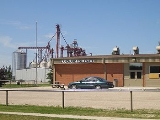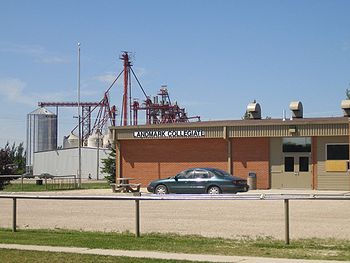
Landmark, Manitoba
Encyclopedia
Landmark is a hamlet
in the province of Manitoba
, Canada
, located about 30 km southeast of the provincial capital, Winnipeg
in the Rural Municipality of Taché
. It has a population of approximately 1500 people (as of 2010). Landmark serves largely as a dormitory community or exurb
for people who work in Winnipeg but prefer to reside in a small-town environment. The Landmark businesses have, through the years, highlighted that the town lies on the longitudinal centre of Canada.
The Landmark businesses have, through the years, highlighted that the town lies on the longitudinal centre of Canada.
The town lies in an area with rich black soil known to yield fine crops. Situated in a low-lying area, the town relies on drainage provided by the constructed Seine River Diversion to minimize flooding caused by the spring melt.
families had purchased land in the area and had begun establishing their new farms. Within a year of that, the area had its first church building, and by 1925 a school district had been organized.
The main transportation link in the Landmark area in the early years was the Old Dawson Trail, a crude road that led westward to Winnipeg and eastward to the small town of Ste. Anne.
In about 1920, the east part of the area of Prairie Rose was registered as the name "Landmark", being picked at random from a list of names in the "Farmer's Advocate" by early resident Peter M. Penner and his eldest son.
Numerous businesses sprung up in Landmark in the 1950s. One of the first businesses in the Landmark area, a repair shop named Landmark Motors, opened in 1950, followed the next year by the Landmark General Store. Landmark’s largest business, a livestock and poultry feed supplier called Landmark Feeds Inc, was established in 1954. In 1957, a plumbing and heating business opened, followed a year later by a second repair shop, Lincoln Sales & Service (now Giesbrecht Mechanical).
Persons of Mennonite descent continue to form the largest identifiable group in Landmark, although immigration to the area has altered the demographic in recent years.
Hamlet (place)
A hamlet is usually a rural settlement which is too small to be considered a village, though sometimes the word is used for a different sort of community. Historically, when a hamlet became large enough to justify building a church, it was then classified as a village...
in the province of Manitoba
Manitoba
Manitoba is a Canadian prairie province with an area of . The province has over 110,000 lakes and has a largely continental climate because of its flat topography. Agriculture, mostly concentrated in the fertile southern and western parts of the province, is vital to the province's economy; other...
, Canada
Canada
Canada is a North American country consisting of ten provinces and three territories. Located in the northern part of the continent, it extends from the Atlantic Ocean in the east to the Pacific Ocean in the west, and northward into the Arctic Ocean...
, located about 30 km southeast of the provincial capital, Winnipeg
Winnipeg
Winnipeg is the capital and largest city of Manitoba, Canada, and is the primary municipality of the Winnipeg Capital Region, with more than half of Manitoba's population. It is located near the longitudinal centre of North America, at the confluence of the Red and Assiniboine Rivers .The name...
in the Rural Municipality of Taché
Taché, Manitoba
Incorporated in 1880, Taché is a rural municipality in Manitoba, Canada. Named after the Bishop Taché , it is located to the south-east of Winnipeg, stretching from the Red River Floodway in the west to the beginning of the Canadian Shield in the east...
. It has a population of approximately 1500 people (as of 2010). Landmark serves largely as a dormitory community or exurb
Commuter town
A commuter town is an urban community that is primarily residential, from which most of the workforce commutes out to earn their livelihood. Many commuter towns act as suburbs of a nearby metropolis that workers travel to daily, and many suburbs are commuter towns...
for people who work in Winnipeg but prefer to reside in a small-town environment.

The town lies in an area with rich black soil known to yield fine crops. Situated in a low-lying area, the town relies on drainage provided by the constructed Seine River Diversion to minimize flooding caused by the spring melt.
History
Although at least four homesteads were established in about 1907, much of the area was barren until just after World War I. It was at this time that a number of families living in neighboring areas faced shortages of land for agricultural expansion. By 1920, a dozen MennoniteMennonite
The Mennonites are a group of Christian Anabaptist denominations named after the Frisian Menno Simons , who, through his writings, articulated and thereby formalized the teachings of earlier Swiss founders...
families had purchased land in the area and had begun establishing their new farms. Within a year of that, the area had its first church building, and by 1925 a school district had been organized.
The main transportation link in the Landmark area in the early years was the Old Dawson Trail, a crude road that led westward to Winnipeg and eastward to the small town of Ste. Anne.
In about 1920, the east part of the area of Prairie Rose was registered as the name "Landmark", being picked at random from a list of names in the "Farmer's Advocate" by early resident Peter M. Penner and his eldest son.
Numerous businesses sprung up in Landmark in the 1950s. One of the first businesses in the Landmark area, a repair shop named Landmark Motors, opened in 1950, followed the next year by the Landmark General Store. Landmark’s largest business, a livestock and poultry feed supplier called Landmark Feeds Inc, was established in 1954. In 1957, a plumbing and heating business opened, followed a year later by a second repair shop, Lincoln Sales & Service (now Giesbrecht Mechanical).
Persons of Mennonite descent continue to form the largest identifiable group in Landmark, although immigration to the area has altered the demographic in recent years.

